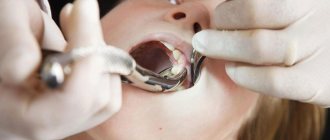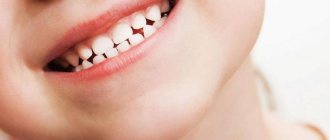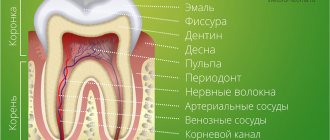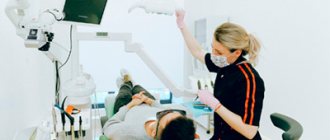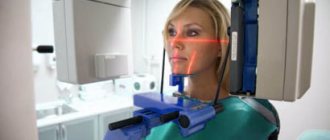Publication date: 04/02/2021
Dental exostosis is a benign formation on the tissues of the jaw bone or on the palatal surfaces. Exostosis is manifested by the formation of hard – bone or osteochondral growths – osteophytes.
Thickening and overgrowth of bone tissue often occurs in children and adolescents. In this case, you need to contact a pediatric dentist. Exostosis can also develop in patients who have suffered a fracture of the jaw bone (then exostosis is localized at the site of fusion of bone fragments) or trauma.
Causes of osteophytes
There is no absolute understanding of the etiology of the process of the appearance of osteophytes. But it can be noted that:
- The risk of developing exostosis increases if there have been inflammatory or tumor processes in the bone tissue.
- Exostosis may appear after tooth extraction. Especially when it comes to the problematic removal of impacted or dystopic wisdom teeth. This is explained by the high probability of bone trauma during this procedure.
- A long and advanced process of periodontal disease can provoke bone growths.
Variants and specifics of classifications of toothless jaws
Edentia or absence of teeth in both jaws is a fairly common situation that can occur not only in elderly patients, but also in fairly young people.
This pathology requires immediate elimination, both due to the lack of aesthetics of the oral cavity and due to the possibility of developing a large number of complications.
However, to choose the right treatment tactics, a specialist needs to correctly study the structural features of the patient’s jaw with missing teeth, which is greatly simplified when using the classifications of toothless jaws available in dental practice.
Symptoms of exostoses of the jaw
In most cases, exostosis does not cause pain or discomfort. Almost the only way to recognize pathology at an early stage is an x-ray, which the doctor sends to a patient who comes in for caries, pulpitis or other problems. However, its peculiarity is the constant increase in size of osteophytes. This means that at a certain stage the patient can feel their presence in the oral cavity.
- The tongue feels a hard formation under the mucous tissue.
- If osteophytes are located on the jaw bones and have grown greatly, discomfort or even pain may occur due to pressure on the surrounding nerve endings.
- Visually, exostosis is visible as an area of a lighter shade than the surrounding mucous tissue on the gum or palate.
- In serious cases, large and advanced exostosis can cause a lisp and other speech defects.
- If pathological bone growths are localized in the “eight” area, they can provoke problems with wide mouth opening.
- The oval of the face changes.
How dangerous are growths on the gums?
A large growth can cause erosion of soft tissues in the mouth.
Due to the absence of pain, elevated temperature, and signs of inflammation, patients consider exostosis to be a harmless disease. But growths can provoke the development of complications.
- As the osteophyte increases, the tongue does not have enough room to maneuver, problems arise with the pronunciation of certain sounds, and the person begins to whistle.
- Due to rubbing of the inner surface of the cheek against the thorn, erosions are formed that do not heal for a long time, phlegmon, abscesses.
- Some osteophytes grow constantly, reaching the size of a chicken egg.
- The functions of the jaw joint are impaired.
- In advanced cases, there is a constant aching pain in the jaw.
A sharp bony protrusion on the upper or lower jaw interferes with prosthetics and leads to permanent destruction of fillings. If the neoplasm passes upward through the cartilaginous plates, chronic rhinitis and sinusitis develop.
There are no specific methods for preventing exostosis. People who have had jaw injuries need to visit the orthodontist 2-3 times a year. It is necessary to regularly examine the mucous membranes of the oral cavity, check the integrity and elasticity of the gums. You should not forget about the rules of dental care, use high-quality toothbrushes and toothpastes.
Online consultation with a doctor
If you are bothered by a growth on the jaw bone that you feel with your tongue, it bothers you, or causes discomfort, then it is best to undergo an examination and seek advice from a dentist. Because these may be symptoms not just of exostosis, but of a more global disease, which, if neglected, will lead to the necessary more complex and expensive treatment: cytology testing and surgical intervention. The specialist will listen carefully, visually assess the condition and color of the fabric and give appropriate recommendations. With this information, you can safely begin treatment.
Classification of toothless jaws
The classification to a certain extent determines the treatment plan, facilitates the relationship between doctors and facilitates recording in the medical history; the doctor clearly understands what typical difficulties he may encounter. None of the known classifications claims to be an exhaustive description of toothless jaws, since there are transitional forms between their extreme types.
Schroeder (1927) distinguished three types of upper edentulous jaws.
The first type is characterized by a well-preserved alveolar process, well-defined cusps and a high palatal vault. The transitional fold, the places of attachment of muscles, folds of the mucous membrane are located relatively high.
This type of toothless upper jaw is most favorable for prosthetics, since there are well-defined points of anatomical retention (high arch of the palate, pronounced alveolar process and tubercles of the upper jaw, high points of attachment of muscles and folds of the mucous membrane that do not interfere with the fixation of the prosthesis).
In the second type, an average degree of atrophy of the alveolar process is observed. The latter and the cusps of the upper jaw are still preserved, the palatine vault is clearly defined. The transitional fold is located somewhat closer to the apex of the alveolar process than in the first type. With a sharp contraction of the facial muscles, the fixation of the prosthesis may be disrupted.
The third type of toothless upper jaw is characterized by significant atrophy: alveolar processes and tubercles are absent, the palate is flat. The transitional fold is located in the same horizontal plane with the hard palate.
When prosthetizing such a toothless jaw, great difficulties are created, since in the absence of the alveolar process and tubercles of the upper jaw, the prosthesis gains freedom for anterior and lateral movements when chewing food, and the low attachment of the frenulum and transitional fold contributes to the shedding of the prosthesis.
A.I. Doynikov expanded Schroeder’s classification by adding to it:
The fourth type is a well-defined alveolar process in the frontal region and significant atrophy in the lateral regions
Fifth type - Pronounced alveolar process in the lateral sections and significant atrophy in the frontal section.
Keller distinguished four types of edentulous mandibles.
In the first type, the alveolar parts are slightly and uniformly atrophied. The evenly rounded alveolar ridge is a convenient base for the prosthesis and limits its freedom of movement when moving forward and to the side.
The attachment points of the muscles and folds of the mucous membrane are located at the base of the alveolar part. This type of jaw occurs when teeth are removed at the same time and alveolar ridge atrophy occurs slowly.
It is most convenient for prosthetics, although it is observed relatively rarely.
The second type is characterized by pronounced but uniform atrophy of the alveolar part.
In this case, the alveolar ridge rises above the bottom of the cavity, representing in the anterior section a narrow, sometimes even sharp, like a knife, formation, unsuitable as a base for a prosthesis. The muscle attachment sites are located almost at the level of the ridge.
This type of edentulous lower jaw presents great difficulties for prosthetics and obtaining a stable functional result, since there are no conditions for anatomical retention, and the high location of muscle attachment points during their contraction leads to displacement of the prosthesis. Using a prosthesis is often painful due to the sharp edge of the maxillary-hyoid line, and prosthetics in some cases are successful only after smoothing it.
The third type is characterized by pronounced atrophy of the alveolar part in the lateral sections with relatively preserved alveolar ridge in the anterior section. Such a toothless jaw is formed with the early removal of chewing teeth.
This type is relatively favorable for prosthetics, since in the lateral sections between the oblique and mylohyoid lines there are flat, almost concave surfaces, free from muscle attachment points, and the presence of a preserved alveolar part in the anterior part of the jaw protects the prosthesis from displacement in the anteroposterior direction.
In the fourth type, atrophy of the alveolar part is most pronounced in the front, with its relative preservation in the lateral sections. As a result, the prosthesis loses support in the anterior region and slides forward.
I.M. Oksman (1967) proposed a unified classification for the upper and lower edentulous jaws.
According to his classification, there are four types of upper edentulous jaws.
In the first type , a high alveolar part, high tubercles of the upper jaw, a pronounced arch of the palate and a high location of the transitional fold and points of attachment of the frenulum are observed.
The second type is characterized by moderate atrophy of the alveolar ridge and cusps of the upper jaw, a shallower palate and lower attachment of the mobile mucous membrane.
The third type is characterized by significant but uniform atrophy of the alveolar edge, tubercles, and flattening of the palatine vault. The mobile mucous membrane is attached at the level of the apex of the alveolar part.
The fourth type is characterized by uneven atrophy of the alveolar ridge, i.e. combines various features of the first, second and third types.
The first type of toothless lower jaw is characterized by a high alveolar ridge, low location of the transitional fold and points of attachment of the frenulum.
In the second type, moderately expressed uniform atrophy of the alveolar part is observed.
This is interesting: Clasp denture with clasps - features, pros and cons
The third type is characterized by the absence of the alveolar edge; sometimes it is present, but poorly. Atrophy of the jaw body is possible.
In the fourth type, uneven atrophy of the alveolar part is noted, which is a consequence of the removal of teeth at different times.
V.Yu. Kurlyandsky proposed his classification of types of lower jaw.
This classification takes into account both the atrophy of the alveolar process and the topography and sites of muscle attachment:
The first type - the alveolar process protrudes above the level of muscle attachments on the inner and outer sides.
The second type - the alveolar process and the body of the jaw are atrophied to the level of the muscle attachment points on the inner and outer sides.
The third type is atrophy of the jaw body below the level of muscle attachment.
The fourth type is more pronounced atrophy in the area of the chewing teeth.
The fifth type is more pronounced atrophy in the area of the front teeth.
Anatomical
It is removed using standard impression trays and a large amount of dental plaster. Has high edges.
Functional tests are not used in this case, as a result of which the condition of the tissues bordering the prosthetic bed is not taken into account.
Functional
To make this type of impression, a personal spoon and special functional tests are used, with the help of which the mobility of the folds of the mucous membrane is reflected.
The edges of the impression are slightly lower than those of the previous type, and the border of the manufactured prosthesis covers the mucous membrane by no more than 2 mm.
Based on pressure on the oral mucosa, functional impressions are divided into three types:
- unloading – removed using a plaster mass using minimal pressure on the mucous membrane;
- compression - used when the mucous membrane is highly pliable, and is performed under pressure using silicone, gypsum or thermoplastic mass;
- combined - allow you to compress areas of the mucosa with high compliance, without overloading areas with low compliance.
Unloading impression
With its help you can minimize pressure on the mucous membrane. Relief impressions are made using plaster without pressure.
There are 2-3 holes on the palatal side of the individual spoon. When pressed, excess plaster flows out through them. This minimizes pressure on the palate.
Compression impression
It is used for pliability of the mucous membrane. It is removed using thermoplastic, silicone and alginate materials. They are inserted into the mouth under pressure. In some cases, gypsum can also be used. However, in this case the pressure must be continuous. There should be no holes in the spoon.
Functional suction impression
It is also removed with an individual spoon. However, the boundaries of such a print should be slightly larger and overlap the neutral area by 1-2 mm. The oral edge of the upper part should be 1-2 mm behind the “A” line.
Diagnostics
If there are visual symptoms of exostosis, the doctor prescribes diagnostic measures to the patient to confirm the disease and differentiate benign bone growth from malignant processes. For this purpose, a person is sent to:
- X-ray – after receiving the image, the dentist sees exactly the size of the formation, its location, as well as the presence of contact with the roots of neighboring teeth, which can lead to damage.
- Biopsy and tissue cytology - based on the research, one can make an unambiguous conclusion about whether the bone growths are osteophytes and the patient has exostosis, or whether it is a tumor process.
T
Dentistry Apex-D / Questions and Answers / Dictionary / T
TAURODONT. Teeth with a very large pulp chamber filling most of the root. They are found during excavations, since such teeth are characteristic of ancient people (for example, Neanderthals). HARDNESS of the material. Defined in many ways. The simplest Mooss method. The Mooss hardness test of materials is carried out by scratching with minerals selected in a certain increasing sequence of hardness. Metals used in denture technology have different hardnesses. TELEMAN'S symptom. Functional overload of the anterior teeth on one side due to the blockade of movements from the mutual movement of the upper and lower molars of the same side. TELERENTGENOGRAM - a survey x-ray of the skull (can be direct or lateral), on which the bone skeleton and soft tissues are projected, is a necessary part of the diagnosis and development of a treatment plan. THERMAL CONDUCTIVITY. The ability of a body (substance) to transfer heat when heated from one end or from one surface to another. “Med Three D” TECHNOLOGY is a computer program that allows you to create a virtual image of the jaws and virtually determine the optimal location and angle of the future implant. Based on the obtained virtual data, a real template is created for installing the implant in the oral cavity. PRESSING TECHNOLOGY (Empress) is a set of laboratory methods for manufacturing all-ceramic dentures of various types under high pressure and at high temperatures - filling inlays, veneers, all-ceramic crowns and short bridges (compensating for the absence of one, two or three teeth). One of the most modern and promising areas of orthopedic dentistry. TORTOANOMALY is a case when the lateral surfaces of the teeth are turned towards the tongue or the teeth are turned 180 degrees TORUS PALATAL - a thickening of the palatal suture found in some people; when large, it makes it difficult to use removable dentures. TOTAL. Whole, general, complete (for example, a defect in the dentition). INJURY. Wound, damage, disruption of tissue integrity as a result of exposure to an external factor. TRAGUS. Cartilaginous formation at the anterior wall of the external auditory canal. TRACTION. Sipping. TRANSVERSAL movements of the lower jaw. Lateral movements of the mandible result from contraction of the lateral pterygoid muscle on one side. Thus, when the jaw moves to the right, the left lateral pterygoid muscle contracts, and when moving to the left, the right muscle contracts. With this movement, the head on one side rotates around an axis running almost vertically through the ramus of the lower jaw. At the same time, the head of the other side, together with the disc, slides along the surface of the articular tubercle. If the lower jaw moves, for example, to the right, then on the left side its head moves down and forward, and on the right side the articular head rotates around a vertical axis. Transversal movements are characterized by certain changes in the occlusal contacts of the teeth. As the lower jaw shifts to the right and left, the teeth describe curves intersecting at an obtuse angle. The farther the tooth is from the head of the lower jaw, the greater the angle. The most obtuse angle is obtained from the intersection of the curves formed by the movement of the central incisors. This angle is called the transversal incisal angle, or gothic angle. It determines the range of lateral movements of the incisors and is wounded at 100-110°. TRANSPLANTATION. Transplantation of tissue of skin, mucous membrane, nerve, bone, etc. from its usual location to cover or correct a tissue defect. Dental transplantation refers to the placement of extracted teeth into an empty socket of the same or another individual. TRANSPOSITION. Incorrect position of individual teeth when teeth change places in the dental arch during a normal bite. THREE spaces between teeth that occur when small teeth grow in a large jaw. See also diastema TREPHANATION OF THE TOOTH CROWN - excision of tooth tissue to provide access to the root canals. CRACK. A linear defect within the epithelium only or including the layer of the mucous membrane itself, resulting from loss of tissue elasticity. The shape of the crack resembles a wedge, the top of which faces deep into the tissue. LOCKJAW. Convulsive clenching of the jaws. TROPHIC. Nourishing, nourishing. TUBE. Tubercle, elevation (elevation on the posterior surface of the body of the upper jaw, on the facial surface of the zygomatic arch, articular tubercle).
You can make an appointment at Apex-D Dentistry by calling the administrator at +7 and +7, or filling out an electronic form (the administrator will contact you at the specified phone number and agree on the date and time of the appointment).
Causes, symptoms, diagnosis
The reliable reasons for the formation of exostosis have not yet been established. However, among the most common factors leading to the development of the disease are injuries, inflammatory processes occurring in the bones, and congenital jaw anomalies. In addition, the appearance of osteophytes may be a consequence of general diseases, for example, insufficient function of the endocrine system.
Small osteophytes do not cause complaints from the patient - there is no pain, the mouth opens freely and fully, the mucous membrane in the area of the growth does not have pronounced pathological changes. Therefore, most often exostosis is detected by a dentist - during a preventive examination or in preparation for prosthetics.
Diagnosis of the disease is carried out on the basis of X-ray data. The image clearly shows a bone growth that is not fused with the surrounding tissues and has clear boundaries.
Mandibular exostosis with the formation of osteophyte on the inner surface of the alveolar process.




